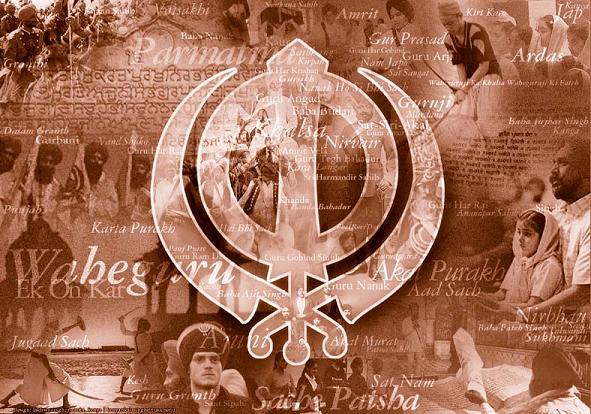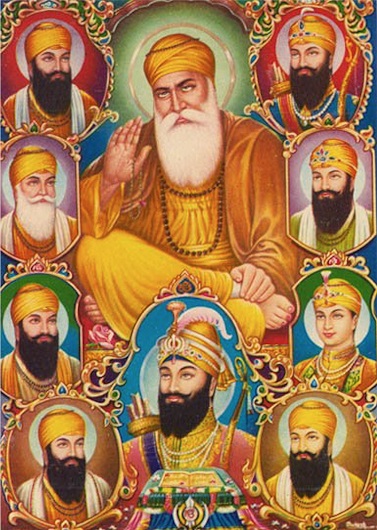Difference Between Budhist & Khalsa “Singhs”
A Dr Ambedkar Mission activist, Biba Kamlesh Ahir was speaking to a small, rather inattentive audience in Italy on 20 April 2008. In her loud crass Panjabi, she treated them like a bunch of school children, punctuating her “bhashan” with, “Your brain is not working. You know nothing…These people go around wearing Kirpans. Their brain is not working…(Inha daa dimaag khraab ho gaya!) ….”
Budhism, she claimed, is the source of Sikh ideology. There is nothing new in Sikhism. Concepts like “sikh” and “singh” are of Budhist origin as is the concept of “Panj Pyaras” (the Five Beloved Ones). Even the martial art tradition of the Khalsa is of Budhist origin! Her drivel would have gone unnoticed, if not for a video released on the networks some months later.
The function, celebrating the birthday of Dr B R Ambedar was organised by Baba Sahib B R Ambedkar Welfare Association, Italy. She said that Baba Ambedkar was the saviour of the Dalits and, especially, women. The lady forgot to mention that by placing transcaste Budhism and Sikhism under the umbrella of Brahmanic Manuvadic caste-based “Hindu” under Clause 25 of the Indian Constitution, Dr B R Ambedkar did not do justice to these two independent systems. In this respect, he also let down millions of Dalits in India.
In her later press statements, the lady retracted and stressed that only Budhism and Sikhism can fight the Manuwaadic “boa”.
By the time Guru Nanak Sahib arrived, Budhism had almost disappeared from India, courtesy Shankracharya’s crusade against Budhism with the help of Hindu rulers in the 9th century CE. Whilst the opt-out Budhism allowed itself to be banished from India, the life-affirming Khalsa of the miri-piri (temporal-spiritual) tradition of Guru Nanak-Gobind Singh, stopped the invasions of the plundering hordes from the North-West. The Sikhs also led the independence movement by making about 80% of all sacrifices in the early 20th Century. Following the take over of Tibet by the Chinese, the Budhist Dalai Lama sought refuge in India with thousands of his followers.
It was Guru Gobind Singh who said, “In gareeb Sikhan ko deo(n) paatshahi” (I shall empower the poor Sikhs (casteless Khalsa), to become the rulers of the land” and so it was delivered, as promised in “Raj karega Khalsa”, a couplet which had become popular during Guru Sahib’s time (Bhai Nand Lal). Any suggestion that Budhism is the source of Khalsa ideology shows total ignorance of the underlying life-approach of the two systems, even if there are some important similarities.
For the student of diverse life “paths” (panths) in this life, the main
differences and similarities between Budhism and Sikhism are noted
below. I hesitate to use the rather misleading label “religion” for
these two great systems. Both adopted a revolutionary approach so far
as Manuwadic Brahmanic tradition (Bipran ki reet) is concerned.
That, therefore, is the main similarity: both systems are revolutionary
and based on acquisition of knowledge and practice of egalitarian
principles. They set new human goals and, mostly, reject earlier
traditions. In its own time, over two thousand five hundred years ago,
Budhism was a major departure from the Vedic, Manuvaadic caste based
tradition, an intricate and elaborate labyrinth of superstitious
primitive beliefs in a vast number of gods, goddesses, devtas (good
beings) and rakhshas (evil beings) etc. In that respect, the Hinduism
of today has not changed much. Gautama Sidhartha Budha swept all that
overboard, as did Guru Nanak Sahib about two thousand years later.
After Budhism, Sikhism was the next revolution brought about in India by Guru Nanak Sahib’s miri-piri (life-affirming i.e. worldly and spiritual) twin-track ideology.
The main difference is that Budhism is life-negating and Sikhism is life-affirming. More about this important difference later.
The fact that Budhism has no place for “God” (Creator Being) concept, whilst Sikhism is totally God-centred, could be regarded as the next main difference with consequential different approaches in practice. Sikhism believes in soul (atma) being the light of the Creator Being (the Supreme Soul) in all. The atma seeks (longs for) return and merger with its own Source. Despite belief in the cycles of karam (karma) i.e. transmigrations, Budhism denies the existence of a “soul” (atma). This is an area of self-contradiction in Budhist thought.
Budhism believes that all is matter, which keeps changing shape. That nothing is left after death. Therefore, on the one hand it does not believe in a soul, on the other, it believes that matter has a memory which is affected by good or bad deeds and connects one life with the next and so starts the cycle of deeds (karma), from which it is necessary to seek freedom (nirvana). The state of nirvana is that of ultimate bliss (param anand). Achievement of that state is only possible by following the “middle path” – the “ashtaang marag” (literally path which requires 8 qualities): right view, right intention, right speech, right action, right livelihood, right effort, right mindfulness, right meditation. The middle path rejects austerities, penances and self mortification.
The “Three ratan” (three jewels) of Budhism are the Enlightener (budh) i.e. Mahatma Budha himself , the path (matt), and congregation (sangh).
Budhist Panch Sheel (Five ethical or moral rules) are: I shall not hurt any living thing; I shall only take that which is given to me; I shall refrain from sexual misconduct; I shall speak the truth; and, I shall not take intoxicants.
Four social principles (Brahm vihaar) of Budhism: Friendship towards all. Charity towards all. Pleasant thoughts for all. Fair and equal dealings with all.
Six qualities for achieving completeness in life are: Charity towards all. Harmony between word and action. Even temperament to face all difficulties. Enthusiasm for doing good. Mind control. Understanding the reality of things.
With one or two exceptions, similarity of the above approach with Sikh thought is only too obvious. A friendly disposition towards all and virtuous conduct are the central themes.
Now the Four truths in Budhist thought: This world (life) is pain. Pain is integral to all that we see. There are many reasons for this pain. It is possible to destroy this pain. It is possible to attain nirvana (freedom from pain = state of bliss or param anand).
Here, Budhism thought and Sikh thought begin to part company. Sikhism accepts pain willingly in the spirit of “Your Will is bliss for me” (Tera kia meettha laagay.) That is, if pain is in Your Will then I accept it gratefully. Sikhs do not believe that this life is all pain.
We seek help from S. Daljeet Singh’s “The Sikh Worldview”. Guru Nanak’s spiritual experience and his view of the Attributes of God are given in the founding creed of Sikhism, the Mool Mantar. Guru Nanak’s path follows “the line of expression of God’s attributes in the world of man…Hence, Guru Nanak’s system and its growth is entirely different from his contemporary religious systems and their growth.”
The Creator Being “expresses His Love and Attributes in the empirical world, and casts a Benevolent Eye on His Creation. But in Vedanta and other Indian systems, the world is either mithya, illusion, a misery, or a suffering.” Budhism falls in that category also.
The above gives Sikhi its life-affirming approach and distinguishes it from earlier systems including the revolutionary approach, at the time, of Budhism. A Sikh cannot be an opt-out from this world but is a very full participant in God’s service. Thus, constant God awareness (simran) also becomes a constant reminder to serve God by serving His creation, for the two are inseparable. “Sewa” is made a precondition to achieving nearness to Creator Being (Karta Purakh). Simran and sewa concepts go together and that is the basis of Guru Nanak’s miri-piri (active temporal involvement for achieving spiritual progress), twin-track approach to life.
As a consequence of the above approach, to quote S. Dalgit Singh, “monasticism, sanyasa, asceticism, pacifism and withdrawal from life, are rejected, and a householder’s life is accepted as the forum of spiritual activities and growth. Logically, monasticism and celibacy go together, and Guru Nanak categorically rejected both of them.” Obviously, God’s qualities of being “Shelter to the shelterless, Milk to the child, Riches to the poor, and “Eyes to the blind”, can be expressed by the Godman only by being a householder and participating in all walks of life, and not withdrawing from them” and “a corollary to this and to the rejection of celibacy” is “equality between man and woman.”
Continues S. Dalgit Singh, “…we find that in life-negating systems…life is far from real or an arena of spiritual endeavours. The spiritual path and the worldly path are considered separate and distinct. Whether it is Vedanta, Jainism, Budhism, Vaisnavism, asceticism, monasticism, ahimsa, sanyasa or withdrawal from life into Bhikshuhood is the normal course. In consequence, celibacy is the rule, and woman is deemed to be a temptress. ….In Budhism, women Bhikshus are deemed second grade compared to male Bhikshus who are considered senior to them. A male Bhikshu is not supposed to touch and rescue a drowning woman, even if she were his mother…Against this, Guru Nanak not only sanctioned a housholder’s life but stated as to, “How can a woman be called impure, when without woman there would be none.”
“Sikh” word is used for seekers of truth in both systems. In Budhism, one who attains the Truth, blows the horn or conch of truthfulness, preaches it fearlessly to the world and becomes a “singh”. From “sikh” he has become a “singh”, a lion who “roars” his enlightenment, and treads the path of truthful conduct, fearlessly.
When the Sikh establishes a direct link with the Ultimate Reality (Waheguru in Sikhism), then he or she becomes Waheguru’s Khalsa and is prepared to lay down his or her life in following the path of truthful conduct peacefully through martyrdom (shaheedi, Guru Arjan Sahib’s way), or, as the need arises, in the battlefield. Khalsa never surrenders to evil under any circumstances.
Let us be clear. A “Singh” (lion) is the Khalsa, who is directly linked with Akal Purakh (the Ultimate Reality) and serves His creation fearlessly and is prepared to make any sacrifice. The Khalsa is God’s army (Akal Purakh ki Fauj). The Khalsa remains in positive spirit (chardhi kalla) under all circumstances, and is invincible even when facing impossible odds. The Khalsa unsheathes the sword in defence of the weak and human dignity. The Khalsa aspires towards Godly qualities of remaining fearless (nirbhao) and without animosity (nirvair) even in the battlefield. The Khalsa is always prepared to give own life as sacrifice for the beloved Lord of all creation. That is the spirit of Sikh martyrdom (shaheedi) – human life is sacrificed in love for the Beloved i.e. in the service of His creation and in acceptance His Will (bhana). The Khalsa is committed to “halemi raj” in which no one inflicts pain on another. The Khalsa is of Waheguru and to Waheguru belongs the ultimate victory.
Whilst the similarities between Budhism and Sikhism are quite remarkable, the founding precepts and approaches are entirely different.
Further reading for the busy reader:
- In English: “The Sikh World View” by S. Daljeet Singh, Institute of Sikh Studies, Chandigarh.
- In Panjabi: “Jain Matt, Budh Matt te Gurmatt”, Sikh Missionary College, Ludhiana.
© Copyright Gurmukh Singh (U.K.)
E-mail: sewauk2005@yahoo.co.uk
Please acknowledge quotations from this article
Articles may be published subject to prior approval by the author


